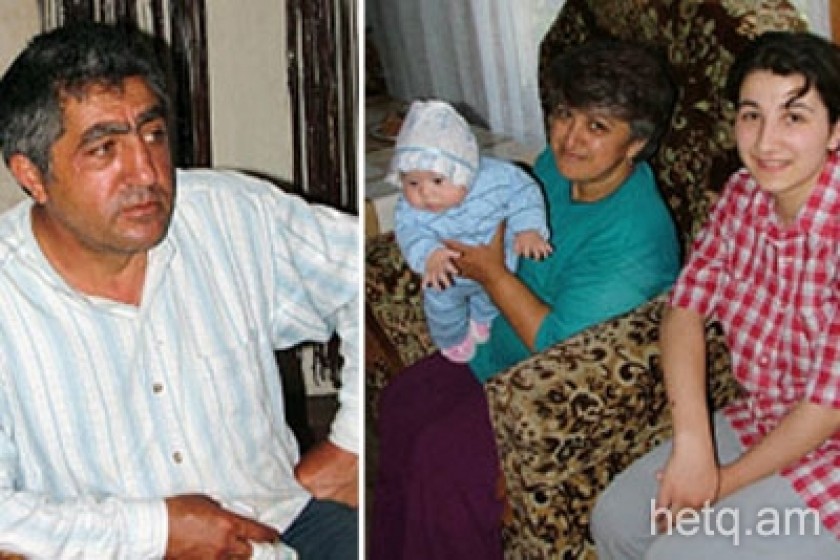
Kashatagh Is For The Educated And Those Families With Many Children
Vazgen Arghumanyan was the first resident of the village of Artashen located in the northern reaches of Kashatagh. He used to work at the tourist center in Jermuk as a photographer and moved her in 1994. Vazgen held the office of village mayor for twelve years. Seated in his comfortable house and sipping from a cup of black coffee he assures us that Artashen is much different than other villages in the area.
“ We've had electricity since late 1994. Our village was the first to be connected to the grid. After the war ended we made sure that the power lines and columns weren't dismantled and carted-off as booty.”
The villagers also didn't allow the razing of the large school building and all its belongings that was left behind by the Azeris.
Vazgen states that none of the Armenians who moved here have left and that they don't intend to. It was Vazgen who brought most of those early settlers to the village in 1994.
The criteria that he used when choosing potential new residents were that they had to be educated and have more than one child. Today, children make up 60% of the village and there's no shortage of trained professionals in the school that boasts over 40 pupils.
The village school has seen many of its pupils go on to graduate from higher educational institutions. They mostly go to Stepanakert to continue their studies since it's closer and less costly than Yerevan. Upon graduation they return to the village and work in the school. Given the needs of the village residents, most students choose to pursue careers in teaching. In fact, the school employs some 40% of the village populace.
“At least one person from every family works for the school, some full-time and others part-time. This is how I envisaged things in the early years and I said as much. This way every family could earn enough to at least purchase basics like flour.”
Vazgen has two sons. The eldest is married with a three-month old baby. Both of the boys help their father take care of the livestock and the beehives. The youngest also works in construction.
“The Tamara Corporation is preparing to build a diary plant in Artashen, notes Vazgen. We're also working on supplying the village with water for irrigation. Right now, there's a lot of work going on here.”
The former village mayor recounts that before arriving here he couldn't tell the difference between a cow and a bee. He started keeping bees by accident. One day he noticed that a bee had been buzzing around in his garden. Instead of chasing the insect away he took it as an omen from above. Today he has over 100 hives.
Vazgen tells us, “ That everyone in the village lives according to the following principle: ‘ In order to live you must work and not place your hopes on others ‘. Otherwise you'll wind up with people sitting on their hands for years waiting for any kind of government hand-out.”
“ We've never really witnessed any type of government assistance here, especially during the past five or six years. Back in 2000 there were some 15,000 – 20,000 households in Kashatagh but there's been a major exodus in recent years. In those areas with electricity they were charging people with no means to pay some 20-25 drams per 1 kilowatt of usage. (Now each family is allocated 60 kilowatts free of charge – H.H.) Even today there are villages without power or water for drinking and irrigation. Naturally, many can't tolerate living in those conditions, they feel neglected and they leave. I don't blame those who leave. Rather, I blame the government. What we need here is investment and low-interest loans so that people can raise livestock. We really have some excellent pastureland here. On the other hand, notes Vazgen, I was confronted with the same conditions when I arrived here as well. But I brought in water, planted gardens and got a hold of bees and livestock. No one was ready to help me. But did I fold my hands and sit and wait?”
Vazgen's convinced that one can lead a normal life here if the person works and doesn't mop about. It's possible to earn up to $2000 a year by raising livestock. There's no problem in delivering meat and dairy products to the market since the sellers come here to make their purchases. Also, walnuts and hazelnuts grow in abundance here. One can sell a kilo of walnuts for 50 – 100 drams.
Of course, Artashen still faces some unresolved issues. For example, the only pastime for the kids remains to tag along behind the grazing livestock. There's no health clinic. However Vazgen's convinced that the new governor of Kashatagh who “ appears to be a capable leader “ will start tackling these issues.
This year Vazgen Arghumanyan was appointed head of the village of Vardut, which is in the preliminary stages of construction. Vardut is envisaged to serve as the administrative center for all villages in the northern area. A hospital, plus some 20 – 30 homes, are expected to be built there.
Vazgen states that, “ One house in the village will be allocated to the policeman who'll maintain law and order. We Armenians can't live if there's no supervision from above. We don't like freedom.” The second structure will go to house the fire brigade.
Vazgen is ready to employ the same yardsticks to select the future residents of Vardut that he's always used – families with children (at least three) and literate people with skills. He's prepared to scour all of Armenia to locate suitable candidates. Notices to this effect have already been sent to the marzes of Ararat and Vayk.
 Videos
Videos Photos
Photos
Comments (2)
Write a comment